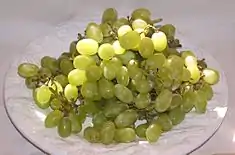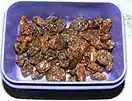Sultana (grape)
The sultana is a "white" (pale green), oval seedless grape variety also called the sultanina, Thompson Seedless (United States), Lady de Coverly (England), and oval-fruited Kishmish (Iraq, Iran, Israel, Palestine, India).[1] It is also known as İzmir üzümü (grape of İzmir) in Turkey since this variety has been extensively grown in the region around İzmir. It is assumed to originate from (Asia Minor), which later became part of the Ottoman Empire.[1] In some countries, especially Commonwealth countries, it is also the name given to the raisin made from it or from larger seedless grapes; such sultana raisins are often called simply sultanas or sultanis. These are typically larger than Zante currants (which are also a kind of dried grape, not currants in the botanical sense), and the Thompson variety is smaller than many seeded raisins. In the US and Canada, the name "raisin" is applied to all dried grapes, so that the breakfast cereal known as "sultana bran" in Australia, New Zealand and the United Kingdom is called raisin bran in the United States and Canada.[2]
| Sultana | |
|---|---|
| Grape (Vitis) | |
 Sultana (Thompson Seedless) grapes | |
| Color of berry skin | Blanc |
| Species | Vitis vinifera |
| Also called | sultanina, Thompson Seedless, Lady de Coverly, oval-fruited Kishmish, İzmir üzümü |
| Notable regions | Aegean Region |
| VIVC number | 12051 |
Thompson sultana raisins are small and sweet, and have a golden colour.[3] Another seedless grape variety from the former Ottoman Empire, the round-fruited Kishmish, is also dried to make a larger sultana raisin.[1]
History
The sultana raisin was traditionally imported to the English-speaking world from the Ottoman Empire. Turkey and Australia are major producers.[4]
American sultana grapes are almost invariably Thompson Seedless, a name that refers to William Thompson, a viticulturist who was an early grower in California and is sometimes credited with introducing the variety.[1][5][6] According to the US Code of Federal Regulations, the two names are synonymous.[7] Virtually all of California raisin production (about 97% in 2000) and roughly one-third of California's total grape area is of this variety, making it the single most widely planted variety.[6][8]
The Ottomans took the sultana grape variety to the island of Crete in the 19th century.[9]
Raisins


In the US, most raisins, including those with the typical dark brown colour, are made from the sultana grape, the Thompson Seedless. The term "sultana" refers to golden-coloured dried grapes, which may also be called "golden raisins" (such as marketed by Sun-Maid, a California-based raisin grape growers' co-op and legacy brand). Any kind of grape may be used to produce golden raisins, and any kind of golden raisins from any kind of grape may be marketed as "sultanas". Moreover, the golden colour may come from a treatment with sulfur dioxide rather than traditional drying and preservation methods.[10] Most nonorganic sultana grapes in California and elsewhere are treated with the growth-inducing plant hormone gibberellin. In other grapes, gibberellin is released by the seeds.[11]
In some jurisdictions, seedless dried grapes are classified as sultana and Thompson raisins according to the drying method used. Sultanas are steeped in a solution of water, potassium carbonate, and vegetable oil to hasten the drying process. Thompson raisins are not treated with this solution, but are dried naturally, thus they require more drying time than sultanas. Because of this, Thompsons are a darker colour than sultanas.[12]
Other uses
Sultana raisins are eaten as a snack food without further processing and are used in a variety of dishes, such as fruitcake and Bath buns, sometimes prepared by soaking in water, fruit juice, or alcohol.
The sultana grape is also used to make white wine, in which use it is known for its "sweet blandness".[5][6] It is referred to as a "three-way grape" because it is used as table grape, to make raisins, and to make wine.[13] In the United States it is the base for wine generically called "chablis".[13] This wine is named for the Chablis region of France, but it is not a true Chablis wine. In the EU, "Chablis" wine must be made from the Chardonnay grape produced in the region of the Yonne département.
End uses include:[14]
- Manufacturing industries such as bakeries and breakfast cereal producers
- Supermarkets
- Dairy products such as yogurt and ice-creams
- Salads and desserts
Its triple use has made the Thompson Seedless the most planted grape in California.[13]
Sultana grape juice was fraudulently sold as being of Chardonnay grapes in Australia for wine making, as Sultana grapes cost less. The fraud was discovered in 2003 by the Australian Wine and Brandy Corporation. It was considered the largest case of wine deception in Australian history.[15]
Sultaniye wines
Sultaniye wines are dry and semi-dry, light-bodied wines produced in Turkey.[16] Sultaniye grapes used in winemaking are mainly grown at Denizli and Manisa, in the Aegean Region of Turkey. Sultaniye grapes are consumed as table grapes and raisins, as well as used in wine making.[17] The Semillon and Sultaniye wines from the Marmara Region of Turkey attract attention not only in the local market, but also in international markets.[16][17][18]
References
- Bioletti, Frederic T. (1918). "The Seedless Raisin Grapes". Bulletin of the California Agricultural Experimental Station (298): 86. Retrieved 2011-12-10.
- "Archived copy". Archived from the original on 2009-09-13. Retrieved 2009-06-25.CS1 maint: archived copy as title (link)
- Royal Botanic Gardens, Kew. "Plant Facts: Christmas: Raisins". Archived from the original on 2006-04-12. Retrieved 2006-06-15.
- "Sultana". Oxford English Dictionary (2nd ed.). 1989.
- "Sultana". American Heritage Dictionary (4th ed.). 2000. Archived from the original on 2005-09-09.
- Appellation America. "Thompson Seedless". Retrieved 2006-06-15.
- "United States Code of Federal Regulations, title 7, section 999.300". Retrieved 2006-06-15.
- United States Department of Agriculture. "California Grape Acreage Report, 2002 Crop". Archived from the original on 2006-04-09. Retrieved 2006-06-15.
- Osmanlı İmparatorluğu ve Girit bunalımı (1896–1908) at Google Books
- "United States Code of Federal Regulations, title 7, section 989.7". Retrieved 2006-06-15.
- Gibberellin and Flame Seedless grapes Archived 2006-12-06 at the Wayback Machine from a University of California, Davis website Retrieved on 2009-04-13
- Metis Broker article
- "Wine Glossary - Words that start with T". Retrieved December 22, 2016.
- Sultanas Archived 2013-10-23 at the Wayback Machine - Bestsultanas.com, London, England
- Winery sold sultanas as chardonnay – Adelaide Advertiser, April 8, 2010
- Cabaroglu, T.; Selli, S.; Kafkas, E.; Kurkcuoglu, M.; Canbas, A.; Baser, K. H. C. (2005). "Determination of Volatile Compounds in Sultaniye Wine by Solid-Phase Microextraction Techniques". Chemistry of Natural Compounds. 41 (4): 382–384. doi:10.1007/s10600-005-0157-0. S2CID 35272688.
- George, Rosemary (2 June 2013). "Turkish Wine Has Vast Potential, Exciting Flavors". Zester Daily. Archived from the original on 6 October 2014. Retrieved 1 October 2014.
- Girişimcilik, p. 82, at Google Books